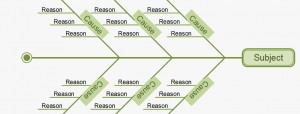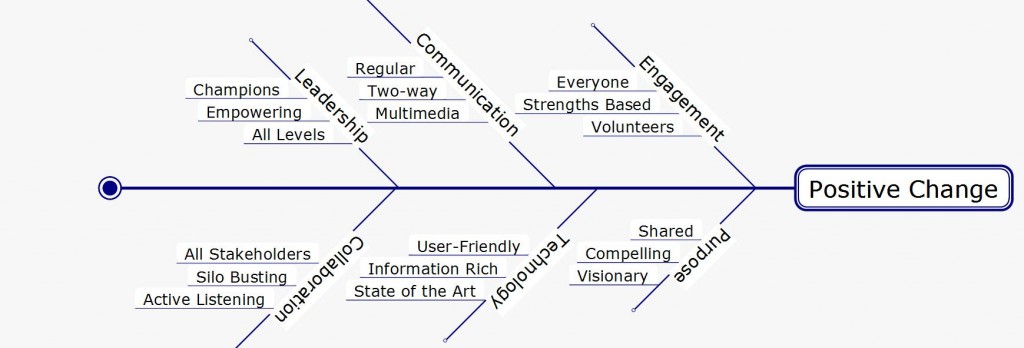I use to think that Vision and Mission Statements was just a consultant/academic type exercise. I did them but I have to honestly admit, it may have been more of an exercise than a real vision. In recent years, working with such a variety of companies, I have shifted my thinking. Without vision, you seldom provide a unifying theme of purpose. All of your objectives, all the measures, all the targets, etc. become disjointed. In a recent interview for a future Business901 Podcast, Ari Weinzweig, CEO and co-founding partner of Zingerman’s in Ann Arbor, MI said, “Vision comes from the heart”. That statement sums it up perfectly.
Recently, I have participated with organizations using Hoshin Kanri and the Balanced Scorecard. These approaches have a remarkable similarity and both are driven by the vision and strategic goals of the organization. These approaches will highlight a lack of vision. You will find great difficulty in completing the process without a crystal clear view of where you want to go. It’s that Why, Simon Sinek explains in his book, Start with Why.
Whether you call it Why or Vision, there is not anything else more instrumental to your success. Do you believe your organization has a heart? Does that mission pulsate throughout the entire organization? It’s not an iterative process. It is not anything that is cloudy or mysterious to your organization. It is Why you get up in the morning and go to work. With Vision, With Why, a unifying theme of purpose exists. All of your objectives, all the measures, all the targets, etc. become aligned.
It’s very similar to Dorothy from the Wizard of Oz! She was running away from home for a better life. They did not understand her. She lacked a vision. Linda, the good witch came back and told Dorothy, “You have had the power all along; you just had to find it.” I encourage you as a business to find your vision and identify with it. Tap those shoes together: Find the Vision, the Why of your organization.
The organization must develop as a whole and this can only be accomplished by developing personnel by providing the necessary resources and opportunities. Instead of teaching the way to do things, we need to step back and determine the key points that are required, as Simon Sinek says the “Why” while leaving the how alone (Start with Why: How Great Leaders Inspire Everyone to Take Action).
Whether you call it Why or Vision, there is nothing else more instrumental to your success. Do you believe your organization has a heart? Does that mission pulsate throughout the entire organization? It’s not an iterative process. It is nothing that is cloudy or mysterious about your organization. It is Why you get up in the morning and go to work. With Vision, With Why, a unifying theme of purpose exists. All of your objectives, all the measures, all the targets, etc. become aligned. And that sense of anticipation, that handling of uncertainty becomes our motivation!
Simon Sinek has a simple but powerful model for inspirational leadership all starting with a golden circle and the question “Why?” His examples include Apple, Martin Luther King, and the Wright brothers — and as a counterpoint Tivo, which (until a recent court victory that tripled its stock price) appeared to be struggling.
Related Information:
Is the Balance Scorecard being revived?
Driving Profit through People and Processes
PDCA Cycle of Zingerman’s Deli
It’s the Who, not the Why @simonsinek
Please watch this presentation
Lean Sales And Marketing Vision (About 5 minutes long)
You will need a Flash Player
Please have your Lean Sales and Marketing Workbook Opened.
Ari Weinzweig Podcast: The Aroma of a Good Vision EBook: The Lean Business Practices of a Deli
Go to the Next Page LSM/CustomerValue
Bonus Material
Root Cause Analysis of Success
One of the Lean tools that is used to determine the root cause of a problem is the Fishbone Diagram, also known as the Cause and Effect Diagram or Ishikawa Diagram. It identifies and explores on a single chart the 5 – Why technique, The aim is to work down through the causes to identify basic root causes of a problem by asking the question why, 5 times.
It appears very simple but the results are outstanding. As a result, it is used very often and one that should be mastered. Why would you use it?
- Allows various categories of causes to be explored.
- Encourages creativity through a brainstorming process.
- Provides a visual image of the problem and potential categories of causes
- Analyze Complex problems that seem to have many interrelated causes
The basic layout for manufacturing consists of six categories: Materials, Machine, Measurement, Methods, Manpower and Milieu (Environment). The basic layout for administrative processes consists of four categories: Personnel, Plant Facilities, Policies and Procedures.
Depending on the situation, other categories are possible. The application is very similar in each:
- Select the Problem Statement, or Effect, shortened into a few key words and place it in a box on the right side of the new diagram.
- Use the categories above or create your own depending on the situation and connect them with a straight line to the “backbone” of the diagram.
- Brainstorm or determine data-driven causes for each category.
- Continue driving down, identifying further lower-level Root Causes.
This classic method is a powerful tool in problem solving methodology. However, can it be equally powerful for creating an analysis of strengths or successes. In the book, Appreciative Leadership , the authors use the Fishbone diagram, depicted below to illustrate the positive core or a group or team.
The authors discuss this approach:
Not only does a root-cause-of-success analysis give you information about your team and your organization at its best; it also shines the light on daily acts of excellence that all too often go unrecognized. It gives credit to high performers and sets the expectation that every-
one else should follow their lead. By illuminating the best of people, processes, teams, Appreciative Leadership signals to others, “do it this way and we will all benefit.”These institutional habits are as hard or harder to change than personal habits. One way to change the “squeaky wheel gets the attention syndrome” is with a root-cause-of-success analysis. By inviting team members or a cross-functional group of people to identify and discuss what causes their success when they are at their best, you send a clear message that what you value and want to understand is success.
The field of Appreciative Inquiry inspires me, finding it quite intriguing. After decades of problem solving, it is not an easy journey to create an appreciative look at business. It is just not a natural instinct for any of us. Using a Positive Fishbone can provide a good visual indicator for teams and leadership.
The authors also gave us 5 core strategies for successful Appreciative Leadership that I found equally enlightening.
- Inquiry lets people know that you value them and their contributions.
- Illumination helps people understand how they can best contribute.
- Inclusion gives people a sense of belonging.
- Inspiration provides people with a sense of direction.
- Integrity lets people know that they are expected to give their best
for the greater good and that they can trust others to do the same.
Accentuate the Positive, Eliminate the Negative is a recent podcast on the subject. Sounds like a good song doesn’t it? My favorite rendition of the song is a Bette Midler & Bing Crosby rendition.
Related Information:
Appreciative Inquiry instead of Problem Solving
My Engagement Strategy – Appreciative Inquiry
Mastering Positive Change


